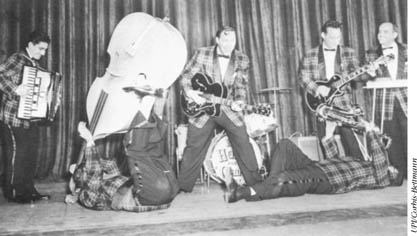
Bill Haley and His Comets rehearse in June 1957, with Bill’s admonition in mind: “Don’t just play, do something!”
It is something of a modern cliché that Bill Haley was the first true rock’n’roller, but rhythm and blues (R&B) had been around a while before Haley heard it, and he wasn’t the best white rocker of the 1950s. He was, perhaps the first white musician to understand fully the appeal of R&B’s gritty sound. And that made him rock’n’roll’s first real star.
Born on July 6, 1925, William John Clifton Haley’s family moved to eastern Pennsylvania while he was a child. He left home at 20 to work in the world of smalltime country/swing, as a disk jockey and performing in a band, in Bridgeport, New Jersey and Chester, Pennsylvania. In 1951, Haley began to shift the sound of his current band, the Saddlemen, away from country and toward African-American music, especially the infectious rhythm of “jump” music, such as that played by Louis Jordan. The group cut a cover version of “Rocket 88” to sell in the white market. The original credited to African-American Jackie Brenston is said to be the first rock’n’roll record. Haley’s cover sold well. Haley followed this with the even-more-feverish “Rock the Joint.” A year later, in 1952, Haley renamed his band Bill Haley and His Comets. Their first single under the new name, “Crazy, Man, Crazy,” climbed to No. 15 in the pop charts. This was the first time that white musicians adopting a black style gained any notice from the mainstream—that is, white—audience. Signed to Decca in 1954, the Comets cut the now-legendary “(We’re Gonna) Rock Around the Clock,” a song straight from Tin Pan Alley, and released it as the B-side of “Thirteen Women.” Despite the song’s energy and brilliant guitar solo, it died on the charts. The group fared better with their cover of Big Joe Turner’s “Shake, Rattle, and Roll,” which reached No. 10.

Bill Haley and His Comets rehearse in June 1957, with Bill’s admonition in mind: “Don’t just play, do something!”
In 1955, a film about juvenile delinquency called Blackboard Jungle hit the movie screens and featured one song prominently. That song was “Rock Around the Clock” and suddenly the single soared back up the charts. Overnight, Haley became a star in both the U.S. and Europe, and the band’s exuberant stage act brought on mass adolescent hysteria. These scenes were repeated in cinemas everywhere with the release of the bland pop film, Rock Around the Clock, during which the fans were dancing in the aisles, and there were repeated scuffles with police.
The years 1955 and 1956 saw several big hits, including “See You Later Alligator,” featuring Haley’s distinctive jive-talk vocal style. “Rock-a-Beatin’ Boogie” and “Don’t Knock the Rock” were other successes. But by 1957, Elvis PRESLEY stole most of Haley’s thunder. At 32, Haley’s fling with stardom was over. Haley’s work would live on, however. “Rock Around the Clock” was given a slot in the movie American Graffiti, and was used as the original theme for the U.S. television comedy, “Happy Days.” All this was apparently of little solace to Bill Haley. After a number of failed comeback attempts and years of hard living, he died of a heart attack in Texas in 1981, at the age of 55.
Greg Bower
SEE ALSO:
COUNTRY; POP MUSIC; ROCK’N’ROLL; ROCK MUSIC.
FURTHER READING
Haley, John W., and John von Hoelle. Sound and Glory: The Incredible Story of Bill Haley (Wilmington, DE: Dyne-American, 1990);
Swenson, John. Bill Haley: The Daddy of Rock’n’roll (London: W. H. Allen, 1982)
SUGGESTED LISTENING
Bill Haley and His Comets; The Original Hits 1954–57; Rock Around the Clock.